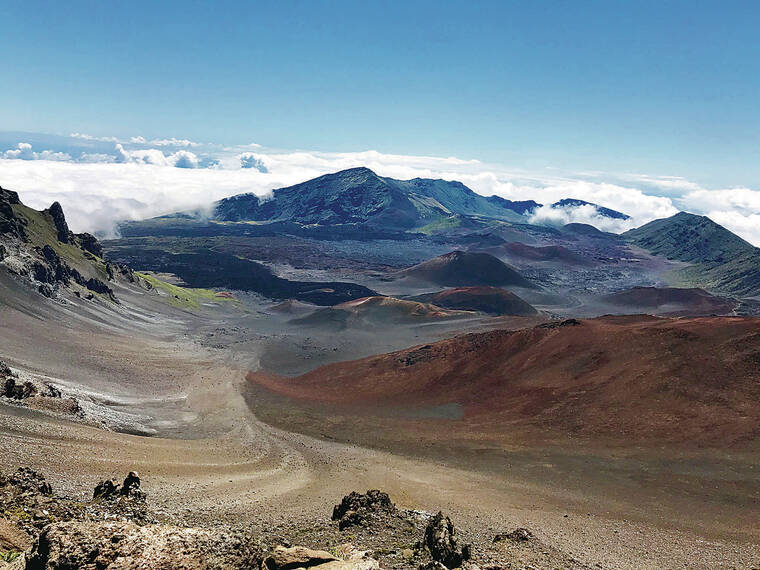Another telescope controvery is brewing, this time on Maui

COURTESY NATIONAL PARK SERVICE
Haleakala Crater may become another site of public conflict as the U.S. Air Force proposes to build seven more telescopes on the summit.
The U.S. Air Force wants to build seven more telescopes on the summit of Haleakala to help better track the growing number of objects whizzing about in space.
But the proposal, unveiled in public meetings on Maui for the first time last week, ran into a buzz saw of resistance similar to the ongoing opposition to the planned Thirty Meter Telescope on Mauna Kea.
Native Hawaiians and their supporters dominated the three “scoping meetings” held to kick off the planning process for an environmental impact statement planned for the Maui Optical and Supercomputing Site Small Telescope Advanced Research, or AMOS STAR, project.
Air Force officials held the meetings, as required by the EIS process, to take comments from community members on the scope of the planning effort.
They were greeted by halls packed with angry opponents who told them to not even bother.
“I came here to say no, no, no,” said Richard Lucas of Haiku, raising his voice with each ‘no.’ “’No’ says everything that needs to be said. It doesn’t mean maybe. It doesn’t mean maybe under different circumstances. It is a total rejection of the proposition, and I say to you: No.”
Don't miss out on what's happening!
Stay in touch with breaking news, as it happens, conveniently in your email inbox. It's FREE!
Lucas was one of hundreds of folks who came out to the meetings in Kahului, Pukalani and Kihei.
Speaker after speaker said the project would desecrate a sacred mountain that already has been violated by the Air Force and others who have telescopes currently operating on Haleakala.
Dane Uluwehi Maxwell, the son of the late Native Hawaiian activist, Charles Maxwell, said the project’s EIS should include a study of generational trauma and its impacts on Native Hawaiians.
Maxwell said he’s seen a deterioration of the mountain’s environment over the years.
“And you folks want more? We can’t give anymore. This is it,” he said.
Mikahala Helm called the mountaintop development an “atrocity.”
“Hear the voices of our kupuna, see them in the clouds, feel them in the breeze. Their love for Haleakala continues with us. They have taught us this way of life, where we malama all that has been given to us for generations to come. We understand that we would not be here if not for Haleakala,” she said.
“No action, no telescope, is the only way,” she added.
The hearings were reminiscent of the TMT scoping meetings held by the National Science Foundation on Hawaii island in August 2022, when scores of Native Hawaiians vehemently objected to construction of the proposed $2.65 million-plus observatory atop Mauna Kea during four meetings held across the Big Island.
The Air Force already operates the 3.6-meter, 75-ton Advanced Electro-Optical System, or AEOS, telescope on the summit of Haleakala. It is the largest optical telescope in the Department of Defense.
In addition, the Maui Space Surveillance System facility houses several other telescopes ranging from 0.4 to 1.6-meters in size.
Under the new proposal, seven more telescopes would be constructed at the Haleakala summit complex. The project calls for construction and operation of six ground-mounted telescopes and one rooftop-mounted telescope, plus the creation of an optics laboratory with communication equipment in an existing building.
The project will require the installation of new utilities, a paved access drive and parking, surface water runoff management measures and other site improvements.
According to the plan, the telescope domes would range in diameter from about 10.5 feet to 33 feet and 12 feet to 35 feet in overall height.
The tallest of the proposed telescope domes would be about a third of the size of the 101.5-foot AEOS telescope and would be further dwarfed by the 143-foot Daniel K. Inouye Solar Telescope, the mountain’s largest astronomical facility.
At 10,000 feet above sea level and with a stable climate featuring minimal scattered surface light, the Haleakala summit will provide excellent viewing conditions most days of the year to allow the observation of objects in space throughout the Pacific Theater, according to the project’s documents.
Following an estimated two years of construction, the AMOS STAR complex would be visited only by Air Force employees and contractors to conduct calibration and maintenance, according to the plan.
The complex would be operated, for the most part, remotely by personnel from the 15th Space Surveillance Squadron of the U.S. Space Force, which is already responsible for the Maui complex.
As part of the EIS process, the Air Force is require to conduct a formal consultation with Native Hawaiians as called for in Section 106 of the National Historic Preservation Act.
Last week’s hearings are not the first time a proposed Maui telescope was challenged by Native Hawaiians and their supporters.
In years past, a small group, Kilakila o Haleakala, filed several lawsuits challenging the construction of what would become the Daniel K. Inouye Solar Telescope, known as DKIST. One of them went all the way to the state Supreme Court.
In addition, Maui protesters — inspired by the TMT opponents— attempted to block shipments of DKIST telescope parts in 2015 and 2017. Some 34 people were arrested during three different protest actions.
Like the TMT project, some of the speakers last week vowed to stand in the way of the AMOS STAR proposal if an attempt is made to start construction.
Kako’o Haleakala, a community group dedicated to protecting the Maui mountain, issued this statement: “We implore the Department of the Air Force to respect the unified and reverberant voices of the community and the rights of our land and our people; DO NOT BUILD THE AMOS STAR TELESCOPES. Do not continue to develop the military industrial complex on Haleakala.”
The group added that, on the contrary, plans should be developed to dismantle the current telescopes there.
Comments are being taken by the Air Force through June 7. They can be emailed to amosstareis@tetratech.com or sent via U.S. Mail: AMOS STAR EIS c/o Tetra Tech, 1230 Colombia St., Suite 1000, San Diego, CA 92101.
The project’s website is at amosstareis.com.





